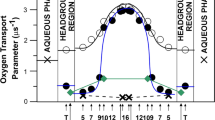Abstract
Oxygen measurements are routinely made either in the vasculature or in the extracellular fluid surrounding the cells of tissues. Yet, metabolic oxygen availability depends on the pO2 within the cells, as does the enhancing effect of oxygen on radiotherapy outcomes. This article reports quantitative modeling work examining the effect of cellular plasma membrane composition on tissue permeability, as a window into tissue oxygen gradients. Previous application of the model indicates that lipid-mediated diffusion pathways accelerate oxygen transfer from capillaries to intracellular compartments and that the extent of acceleration is modulated by membrane lipid and protein composition. Here, the effects of broken intercellular junctions and increased gap size between cells in the model are addressed. The conclusion is reached that the pO2 gradient will likely be consistent among similar, healthy tissues but may increase with increased interstitial fluid fraction and broken intercellular junctions. Therefore, tissue structural changes in tumors and other diseased or damaged tissues may lead to aberrations in permeability that confound interpretation of extracellular oxygen measurements.
Access this chapter
Tax calculation will be finalised at checkout
Purchases are for personal use only
Similar content being viewed by others
References
Subczynski WK, Widomska J, Stein N, Swartz HM (2021) Factors determining barrier properties to oxygen transport across model and cell plasma membranes based on EPR spin-label oximetry. Appl Magn Reson. https://doi.org/10.1007/s00723-021-01412-4
Pias SC (2021) How does oxygen diffuse from capillaries to tissue mitochondria? Barriers and pathways. J Physiol 599:1769–1782. https://doi.org/10.1113/JP278815
Multhoff G, Vaupel P (2012) Radiation-induced changes in microcirculation and interstitial fluid pressure affecting the delivery of macromolecules and nanotherapeutics to tumors. Front Oncol 2. https://doi.org/10.3389/fonc.2012.00165
Longmuir IS (1981) Channels of oxygen transport from blood to mitochondria. Adv Physiol Sci 25:19–22. https://doi.org/10.1016/B978-0-08-027346-4.50007-3
Ghysels A, Vervust W (2022) Oxygen storage in stacked phospholipid membranes under an oxygen gradient as a model for myelin sheaths. Oxyg Transp Tissue. https://doi.org/10.1007/978-3-031-14190-4_49
Wang Q, Dotson RJ, Angles G, Pias SC (2021) Simulation study of breast cancer lipid changes affecting membrane oxygen permeability: effects of chain length and cholesterol. Adv Exp Med Biol 1269:15–21. https://doi.org/10.1007/978-3-030-48238-1_3
Dotson RJ, McClenahan E, Pias SC (2021) Updated evaluation of cholesterol’s influence on membrane oxygen permeability. Adv Exp Med Biol 1269:23–30. https://doi.org/10.1007/978-3-030-48238-1_4
Hilvo M, Denkert C, Lehtinen L et al (2011) Novel theranostic opportunities offered by characterization of altered membrane lipid metabolism in breast cancer progression. Cancer Res 71:3236–3245. https://doi.org/10.1158/0008-5472.CAN-10-3894
Gertsenshteyn I, Giurcanu M, Vaupel P, Halpern H (2020) Biological validation of electron paramagnetic resonance (EPR) image oxygen thresholds in tissue. J Physiol 599:1759–1767. https://doi.org/10.1113/JP278816
The PyMOL Molecular Graphics System, Version 1.7.6.5 Schrödinger, LLC
Acknowledgments
SP acknowledges helpful communication with Harold Swartz and Joseph LaManna as well as thoughtful peer reviews. PyMOL was used for lipid bilayer model imaging [10]. The work was financially supported by gifts from the Glendorn Foundation and Clin-EPR, LLC.
Author information
Authors and Affiliations
Corresponding author
Editor information
Editors and Affiliations
Rights and permissions
Copyright information
© 2023 The Author(s), under exclusive license to Springer Nature Switzerland AG
About this paper
Cite this paper
Pias, S.C. (2023). Do Vascular and Extracellular Measurements Consistently Reflect Intracellular pO2?. In: Scholkmann, F., LaManna, J., Wolf, U. (eds) Oxygen Transport to Tissue XLIV. ISOTT 2022. Advances in Experimental Medicine and Biology, vol 1438. Springer, Cham. https://doi.org/10.1007/978-3-031-42003-0_29
Download citation
DOI: https://doi.org/10.1007/978-3-031-42003-0_29
Published:
Publisher Name: Springer, Cham
Print ISBN: 978-3-031-42002-3
Online ISBN: 978-3-031-42003-0
eBook Packages: Biomedical and Life SciencesBiomedical and Life Sciences (R0)




